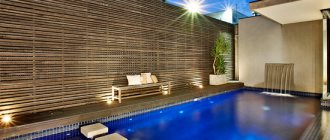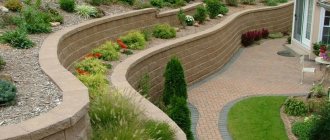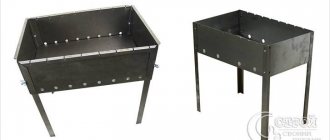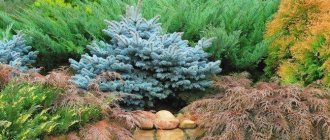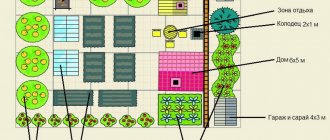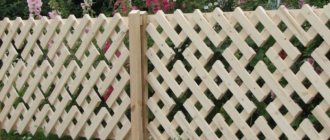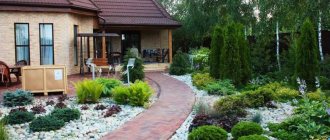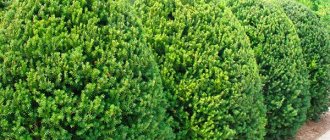Flowerbeds and beds on any summer cottage should have a well-groomed and aesthetic appearance, so it is very important to pay enough attention to their appearance. Experts consider decorative fences to be the best option for their design, which can be either purchased ready-made or made with your own hands. Absolutely any available materials can be used as manufacturing options. Below, the most popular fences are discussed in detail, as well as brief instructions for their implementation.
Functions of internal fences
A fence on a site usually does not fulfill the true function of the structure. You will only need to protect something here from small children and pets. Therefore, it is not customary to install high, solid palisades inside properties.
Decorative fences are often used for beauty. The structure will draw attention to the landscape composition and help highlight certain details.

The fence will also divide the area into zones. A fence is able to highlight a specific object. It is easier to care for it, clearly understanding the boundaries of the composition.

Material selection, selection tips
Since the fence is a decorative element, it means that we are not making it for “the rest of our lives.” It should serve us for at least 5–7 years, and then we will still want to change something, because new design ideas or new flowers will appear. You need to choose the material with which you will be comfortable working. Let's look at the most common ones.
Wood is the most environmentally friendly and affordable material. Fairly easy to use. With proper preparatory treatment it can last up to 10 years.
Plastic and glass bottles are the easiest materials to work with. The downside is that plastic is not an environmentally friendly material and can release toxins into the soil. Glass bottles are easy to break and can cause injury in the future.
Options for building materials in the photo

Original fence made of thin PVC pipes

Colored plastic bottles make a fun fence

Glass bottles are not only for storing alcohol The easiest picket fence to use
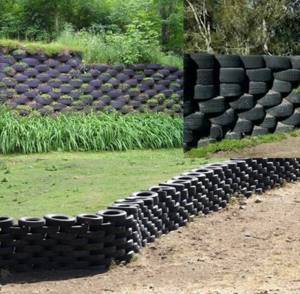
Fence-fortress made of tires
Car tires last a long time, but like plastic, they emit toxins. They look pretty rough.
PVC pipe will last a long time. If you have a special soldering iron, you can simply make an original fence from it.
Nuances of choosing a format
Symbolic fences for a summer residence can enclose a path, lawn or flower bed. Depending on the purpose of the element, its format is selected. The following product options are popular:
- Low fences. The construction is decorative in nature. The product can be easily stepped over. The element is distinguished by its fragility.
- Medium fences. A strong fence up to 50 cm high will protect the plantings from attacks by children and pets.
- Tall buildings. This option is suitable for clear zoning of the territory. The design can be of any density.

Wattle - rural style
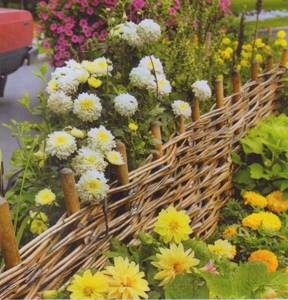
Many will agree that wicker fences are being moved to the village. Therefore, if you are decorating your garden or surrounding area in this style, then wicker decorative fences are the ideal solution. For this you can use flexible branches of willow, cherry, raspberry, grape vines, willow and hazel.

You can prepare rods in spring or autumn. The thickness of the rods can be around 20 mm. To determine the amount of material, you should measure the length and height of the future decorative fence. The manufacturing process is very simple.

Install vertical supports into the ground in 500 mm increments. Weaving begins from the first row. The beginning of the rod can be fixed to the support post using soft wire. After this, guide the rod in a horizontal position so that it goes around each support.
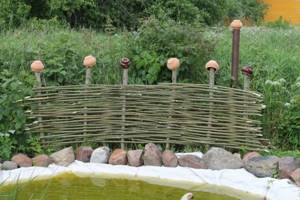
Advice! Each connection of the vine rod should be secured with wire so that the fence does not unravel.
Today you can find ready-made versions of wicker fences on sale. This is in case you don’t have the time or desire to do all the work. There are wicker decorative fence blocks on sale.
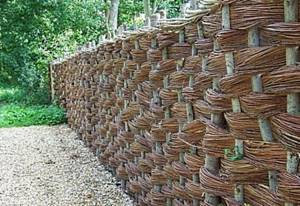
Regardless of the option you use, it is recommended to treat such a fence with paints and varnishes to prevent the negative effects of moisture, dampness, rot, etc. The main feature and advantage of this technology is that you can make a decorative fence of any complexity, configuration and length with your own hands. And most importantly, it will cost you relatively cheap.
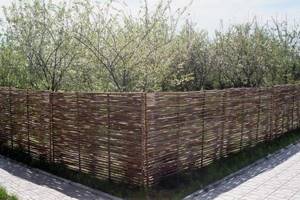
Fence
Wooden planks are placed evenly vertically. The option perfectly limits the territory. The fence can be either low, purely decorative, or standard functional.

A classic picket fence is often painted white or other colors for decoration. Such a fence for a flower bed will be an excellent decoration for the area.
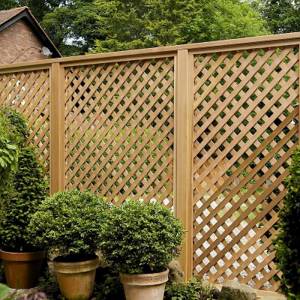
Wood and wood materials
A small fence made of decorative wood may differ in width and arrangement of wooden slats.

Horizontal and vertical or diagonal structures look very attractive and can be used to decorate a garden or green spaces, to enclose playgrounds and play areas.
Metal
It is difficult to make a metal fence with your own hands. An elegant structure requires skill. Forged and welded structures are considered an elite category of fences.

The products are surprisingly decorative in appearance, but have a high price. An acceptable option can be ordered at the factory. Exclusive products are unique and have the most respectable appearance.
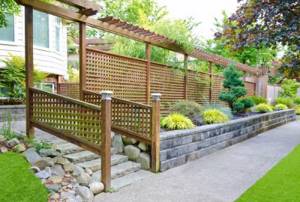
To reduce the cost of construction, decorative fence posts are often used. Metal gratings are fixed between the supports.
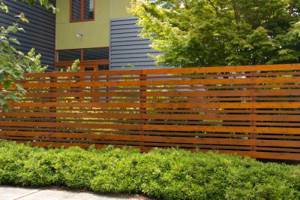
It is even more economical to use scraps of corrugated board. Now, just to create an aesthetic structure from this material you will have to use your imagination.
Mesh, welded and chain-link
Mesh fencing structures are perfect for planting climbing plants and forming hedges.

Grapes and climbing roses, cucumbers and even melons are actively used to decorate such structures, becoming green fences, but mesh fences require supports.

Natural material
Rock cuttings and ordinary pebbles are suitable as materials for fencing. Granite or marble will be expensive, but will recoup the investment with an amazing appearance.

It is cheaper to make a fence from pebbles or sandstone. With the right approach to the matter, the result will be no worse.

Wooden fences
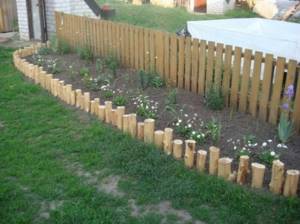
This material is the most common when landscaping a summer cottage. Wooden decorative fences will fit perfectly into your landscape design. Plus, natural wood is always highly valued and has excellent performance characteristics. For this purpose, you can use boards, slats, pegs, logs, branches and the like. In fact, this is a prototype of a large wooden fence and is made using the same technology.
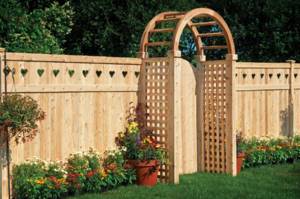
The manufacturing process is very simple. First of all, wooden elements must be treated with anti-corrosion compounds to prevent rotting. It should also be treated with moisture-proof compounds, which will increase the service life of the wooden structure. Particular care should be taken to protect those wood elements that will have direct contact with the ground.
The manufacturing method depends on what material you decide to use. If these are logs, then you should cut the logs of the same or different sizes, with a discrepancy of several centimeters. Before installing them, it is necessary to remove the fertile layer of soil and compact the soil. You can first make an embankment of sand to make the chocks easier to install. Having installed all the posts, add soil from all sides.
If a picket fence is used, then it is necessary to install support posts at a certain interval and attach a decorative fence to them. The advantage of such fences is that there is no need to make a foundation for them. As a result, installation is much faster than if it had to be manufactured.
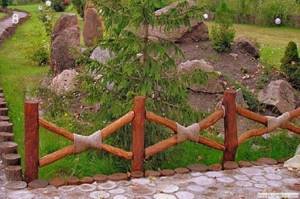
Reminder! Be sure to remove the bark from the surface of the wood; pest beetles may live under it. Also be sure to treat the wood with special anti-corrosion compounds.
Mosaic of rubble
An excellent decorative fence can be made from scraps of building materials. The following materials will be used: pebbles, paving stones, fragments of ceramic products, glass. Brick and stones of various sizes will help complete the picture. Pieces of materials are simply glued together with cement mortar.

Fences for flower beds (garden borders)
There are many interesting ways to beautifully arrange a flower arrangement in the garden:
- Ceramics. A border for a flower garden made from old plates looks wonderful. Even battered cutlery will be used.
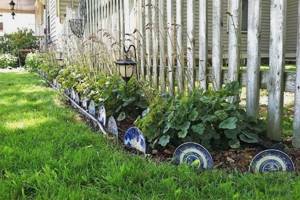
- Glass bottles. Thoroughly clean the container and immerse it in the ground, neck down, leaving about half on the surface. You can give any shape to your fence.
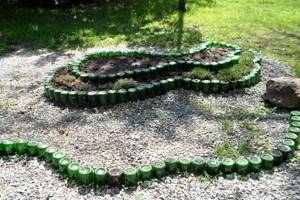
- Plastic bottles. Cut off the neck. Place the remaining part in the ground upside down.
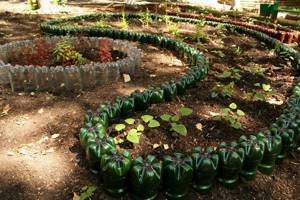
If desired, color as your imagination allows. - A natural stone. You will need stones of different sizes and shapes. Lay them out in several layers, strengthening them with cement mortar.
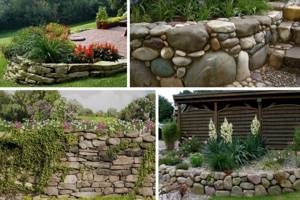
If desired, you can supplement the composition with glass (for example, the bottoms of bottles, broken dishes) or ready-made clay products (for example, small old jugs). - Slate. The material is not particularly durable, but it helps to separate flower beds and is relatively inexpensive. It is enough to dig the pieces of slate into the soil, making sure that all elements of the fence are the same height.

- Brick. Place the rectangles into the soil at an angle, making sure they fit snugly together (you can plant them in cement mortar).
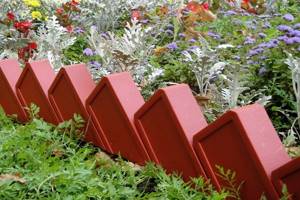
You can also split the bricks into two equal parts to make squares. Deepen one corner into the ground so that even triangles remain above the surface. - Gypsum or cement . Decorate your garden with interesting garden figures. Using special molds, cast various animals and place them like a train, one after another, around the perimeter of the garden. The manufacturing method is as follows:
- take a mold made of plastic or polyurethane;
- prepare a solution in the ratio of one part M 250 cement to two parts sand;
- add water so that the mixture has a structure similar to thick sour cream;
- pour the mixture into the mold;
- wait 1 day;
- remove the product from the mold.
grease with sunflower oil to prevent the workpiece from drying to the mold;

If desired, color or decorate the figurine with patterns.
The fence on the site performs many important functions. First of all, it protects plants and separates flower beds, but with the right approach it can become an original decorative element. To make a truly beautiful fence, you just need to choose the right material and use your imagination.
Concrete and brick
Decorative concrete fences, like their brick counterparts, are popular. The options are economical and allow you to create unusual, stylish compositions.
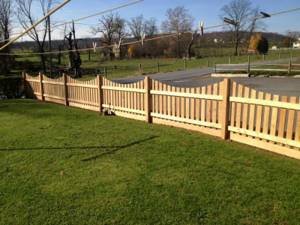
You will have to work hard on the appearance of the structure. The building runs the risk of being crude. You can only aim at a low decorative border. A low-cut product looks softer.

Stylish fence for a flower bed made of reinforcing rods
- We stick reinforcing rods or sections of thin metal pipe into the ground.
- We secure the crossbar with wire along the top of the pins (as can be seen in the picture). You can fasten the rods in another way, tying the place of contact with wire crosswise.
- It is advisable to surround such a fence with stones, paving stones, etc.
Available materials
Waste elements are a unique category of materials. To make fences, they use cans, bottles, lids, old furniture and clothes, tires, and fragments of building materials.
You can create unusual compositions from garbage. All you have to do is use your imagination.

What materials can be used for decorative fencing?
To beautifully and originally complement the idea of landscape design and conceptual design, you can use structures from different materials on the site.
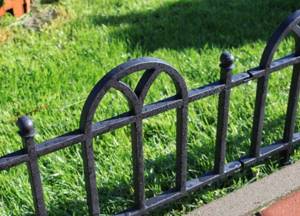
Concrete and brick, natural and artificial stone, metal and wood, improvised and consumable materials are suitable for making fences.

Hedges
With the help of plants you can create an excellent fence. It is not necessary to use large trees and bushes. Flowers will serve as a fence.
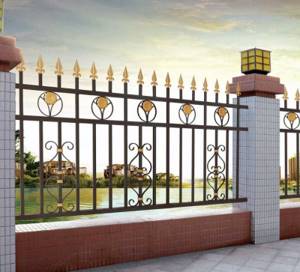
Bushy specimens would be a suitable option. Climbing plants would be an equally good choice. It is permissible to use squat but spreading species.

The fence is no longer just a wall from the outside world. In the interior, fencing products are used as decorative details.

A landscape with such fences becomes modern, interesting, and practical. To create a beautiful exterior of your property, it is enough to choose the right option.

Functions of a decorative fence
The following are distinguished:
- Zoning. When a fence neatly separates the residential part of the estate from the recreation area or the garden from the rest of the yard.
- As limiters. Installation is carried out around the perimeter of planting weaving plants so that they do not become an obstacle to movement. Another option - in high flower beds it serves as protection against soil spillage. Separates individual types of plants.
- Accent. When the owners want to emphasize a particular part of the territory. For example, select a flowerbed in front of the entrance to the house, decorate the lawn around a small fountain.
A well-chosen fence is an element of landscape design. It becomes an addition to the architectural ensemble of the site.
Wood fencing
The first thing that comes to mind when reading such a title is a classic picket fence. Usually a board is used to make it, but wood exists not only in this form. Thick branches can be used as pickets, and long straight poles made from young trees growing in the area can be used as horizontal veins to which the pickets are attached.
Thicker trunks can serve as stands. In the absence of nails or screws, the entire structure can be tied together with wire.
You can limit yourself to installing only the veins. Such a fence, consisting of two or three horizontal poles, is called a “ranch” - it is often used to fence off livestock pastures, not only in the West, but also here.

Branch fencing
If there is nothing to make poles from, picket branches can simply be dug into the ground, wrapping the buried part in polyethylene for waterproofing. The result will be a kind of picket fence.
Finally, pickets can be made from a material that is not entirely available, but still very accessible - slab, which is a woodworking waste. This is the rounded side of a log, cut off during the production of timber or boards.
For biosecurity purposes, wood must be treated with an antiseptic and coated with varnish or paint.
Concrete structures
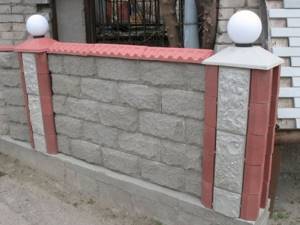
Reinforced concrete slabs can also be used in the construction of a decorative fence. To install them, a small foundation must be made. On sale you can find various decors and style solutions in which concrete fences are made. The sections are installed in installed concrete support pillars, which have grooves.

These supports should first be installed along the entire perimeter or length of the place where you plan to install the decorative fence. Please note that we are not talking about installing two or three concrete slabs. As a rule, such fences serve as fencing around the local area. In our case, one plate will be enough. Such a low fence will perfectly delimit the territory. Moreover, the materials used in its manufacture ensure its long-term operation.
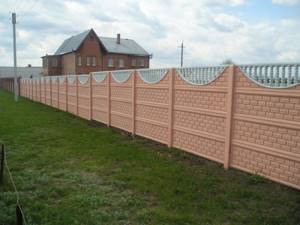
Advice! An installed gray concrete fence can then be painted any color. To do this, you need to use exterior paint.
Common options
When decorating a fence at your dacha with your own hands, you can look at other people’s work or listen to the advice of landscape designers. But they are usually designed for more expensive types of fencing such as a permanent concrete fence, brick or corrugated structures.
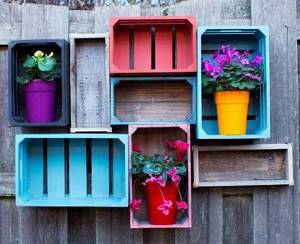
Simple idea
What should a summer resident do if there is an old fence, a simple mesh or a wooden picket fence around the garden plot?
It is not interesting to give them advice, because a person who has such a fence around his garden plot cannot and does not want to spend significant money on decorating it.
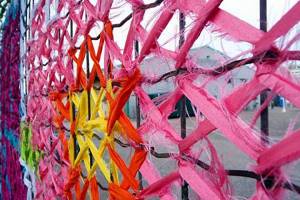
Example of welded mesh decor
You can even cover the mesh with color film with a landscape. Its cost is affordable and allows you to change this decoration every year.
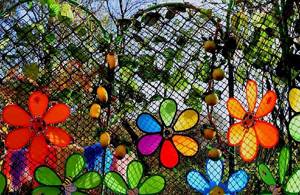
Colorful flowers
There are banal and common options, but they do not work for long and do not improve the situation much:
- It is recommended to simply paint a fence made of chain-link mesh or a very old one made of wood, after first cleaning off the remnants of the old layers and treating it to prevent damage;
- It is recommended to decorate a mesh fence with the help of climbing greenery, flower pots or improvised flower beds;
- it is also proposed to decorate a wooden fence with flowers, but this does not solve problems in cold weather when there are no green spaces;
- decorating a simple picket fence with a green fence, painting it green, is also not a solution: flying leaves will treacherously expose the peeling paint, and everything will return to its former ugly appearance;
- a chain-link fence, even freshly painted, is still a temporary fence that is difficult to make aesthetically pleasing by allowing climbing plants along it;
- a slate fence, according to some advisers, does not need decorations, but the way to make it decorative is still the same - use plants or paint.
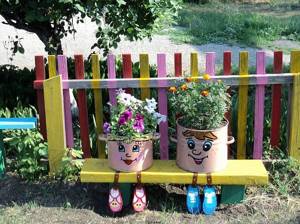
Interesting option
However, studying the experience of other summer residents, it is easy to see, looking at the photo, that you can decorate any fence, even a chain-link fence. If a person has imagination, available tools and a little free time, he can make an original and unique decorative component from anything.
Tire fence
People have long been fond of used car tires as a material for all kinds of fencing. For example, a low side to mark the territory of a flower bed can be built by deepening the tires in a vertical position by half the diameter.
If you need a higher fence, you can do this:
- Lay several tires on the ground, forming a row of the desired length. In places where they touch, the tires need to be fastened with screws or small bolts and nuts.
- Place the 2nd row on top, offset along the fence line by half the tire diameter. Thus, the hole of each tire will be strictly above the junction of the two lower ones - the same ligation of seams. To make the fence more massive, you can pour earth inside the tires.
- Lay the 3rd row, placing the tires in it directly above the tires of the 1st row. Then, in relation to the 2nd row, it will also be laid offset.
Tire fence
Next, you need to continue laying out the fence to the desired height, placing the tires according to the described pattern. Flowers or grass for lawns can be planted in the soil backfill of the top row.
Slate fence
This option is ideal for those who have leftover material from re-roofing. Using scraps you can build a simple decorative fence. Both wavy and flat slate are suitable here. To install it, you need to dig a shallow and narrow ditch. Drive pegs made of reinforcement or wood into the ground around the perimeter. They will serve as a support. You insert the slate directly into the ground close to the installed beam or reinforcement. Afterwards, the trench can be buried and compacted on both sides. The advantage of this type of decorative fence is that there is also no need to make a foundation.
How to decorate a wooden fence: 4 ideas
Brush + paint
The easiest way to decorate a wooden fence is to arm yourself with paint and draw something on it. To do this, you can involve the whole family: children will be delighted with the idea of drawing cartoon characters or simply painting each board a different color. It may turn out to be a color madness, but you will spend time with your family, and the fence will become unique.
A couple of examples of painting on wood may inspire you to experiment:

Windows on the other side
Another example of decor on the courtyard side is an imitation of old window frames, into which colored stained glass or mirrors can be inserted instead of glass. Or you can use the usual “trick” of frames with a window sill. This window sill can be used as a shelf for a flower pot.
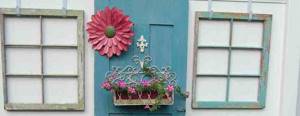
Vertical garden in tins
The advantage of a wooden fence from an aesthetic point of view is its vintage appearance. You can also plant a vertical garden on it, but instead of store-bought pots, use, for example, tin cans painted the same color. It is not necessary to improve the fence itself. Look at the photo on how to decorate a wooden fence with plants in jars:

Forged elements
A calm and beautiful option is forging. Forged elements can be placed both on the courtyard side and on the street side; they combine perfectly with wood, bringing to mind a medieval castle. It is especially beautiful if the metal is painted in a contrasting color.

